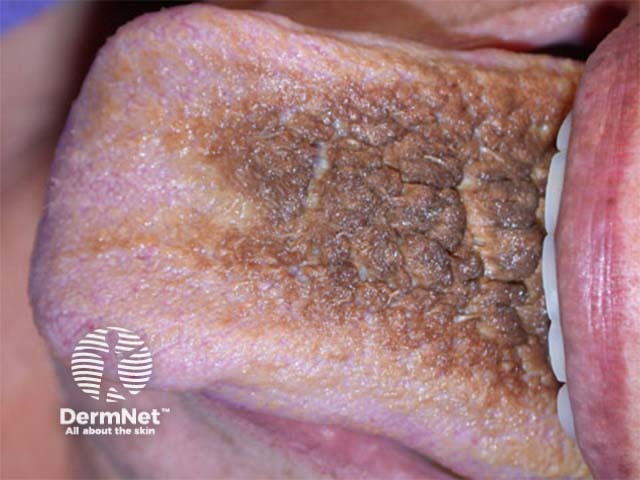Main menu
Common skin conditions

NEWS
Join DermNet PRO
Read more
Quick links
Mixed diagnoses – 10 cases (4 of 11)
For each of the ten cases, study the image(s) and then answer the questions. You can click on the image to view a larger version if required.
Each case should take approximately five minutes to complete. There is a list of suggested further reading material at the end of the quiz.
When you finish the quiz, you can download a certificate.
Case 3

What is the name for the condition shown?
Black hairy tongue (lingua villosa nigra). Hairy tongue may also appear yellow, brown, white, green or pink due to retention of coloured food debris. Defective desquamation of the filiform papillae of the middle and back of the tongue result in hypertrophied and elongated 'hairs' up to 15mm in length. It may be asymptomatic or result in a tickling or burning sensation. Oral debris contributes to halitosis.
How does it arise?
The papillae hypertrophy because they have not been debrided by the rough components of a normal diet. The discolouration is due to bacterial and fungal overgrowth. Predisposing factors may include: poor oral hygiene (lack of tooth brushing); tobacco use; excessive consumption of alcohol, tea and coffee; broad-spectrum antibiotics; psychotropic agents resulting in dry mouth; therapeutic radiation of the head and neck (lack of saliva and a soft diet); immune suppression especially due to HIV.
What treatment would you recommend?
Refer to a dental hygienist if oral hygiene appears poor. Mouthwashes are ineffective. Treat candida if swabs indicate its presence. The patient should brush her tongue twice daily with a soft toothbrush or a tongue scraper. Keratolytic agents such as 40% urea solution, salicylic acid or tretinoin may be useful.
